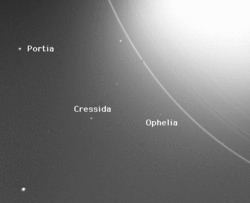Discovery date January 3, 1986 Eccentricity 0.00005 ± 0.00008 Discovered 3 January 1986 | Semi-major axis 66,097.265 ± 0.050 km Average orbital speed 9.37 km/s Orbital period 12 hours | |
 | ||
Similar Stephen P Synnott discoveries, Uranus moons, Other celestial objects | ||
Portia (/ˈpɔːrʃə/ POR-shə) is an inner satellite of Uranus. It was discovered from the images taken by Voyager 2 on 3 January 1986, and was given the temporary designation S/1986 U 1. The moon is named after Portia, the heroine of William Shakespeare's play The Merchant of Venice. It is also designated Uranus XII.
Portia is the second-largest inner satellite of Uranus after Puck. The Portian orbit, which lies inside Uranus' synchronous orbital radius, is slowly decaying due to tidal deceleration. The moon will one day either break up into a planetary ring or hit Uranus.
It heads a group of satellites called the Portia Group, which includes Bianca, Cressida, Desdemona, Juliet, Rosalind, Cupid, Belinda and Perdita. These satellites have similar orbits and photometric properties.
Little is known about Portia beyond its size of about 140 km, orbit, and geometric albedo of about 0.08.
In the Voyager 2 images, Portia appears as an elongated object whose major axis points towards Uranus. The ratio of axes of the Portia's prolate spheroid is 0.8 ± 0.1. Its surface is grey in color. Observations with Hubble Space Telescope and large terrestrial telescopes found water ice absorption features in the spectrum of Portia.
